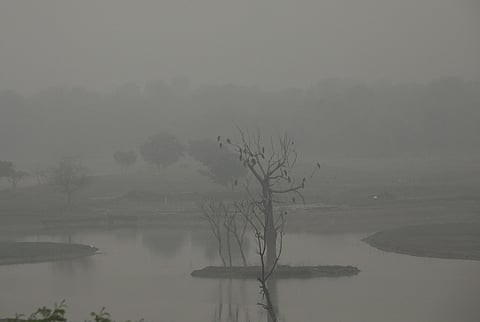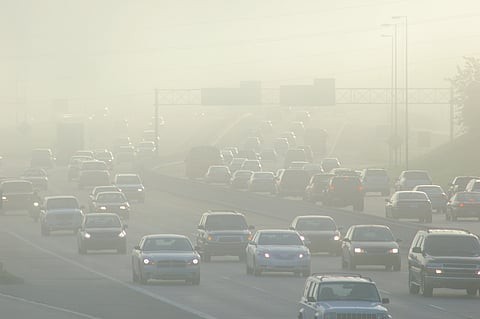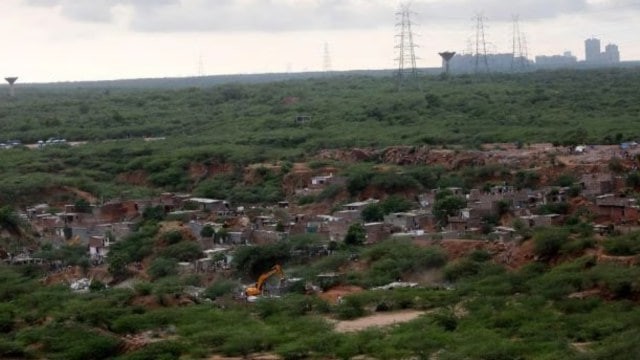



Dust pollution is a significant contributor to deteriorating air quality, mainly arising from construction work, road dust, industrial activities, and natural windblown sources. It increases particulate matter levels, harms human health, disrupts visibility, and affects ecosystems. Effective control requires better regulation, enforcement, dust-suppression measures, greener urban design, and active public awareness.

Copyright infringement not intended
Picture Courtesy: The Hindu
Dust pollution has emerged as a major environmental and public health challenge in rapidly urbanizing and industrializing regions. It primarily consists of fine particulate matter released from construction activities, vehicular movement on unpaved or poorly maintained roads, mining operations, industrial processes, and natural sources like dry soil surfaces. In many Indian cities, dust contributes a substantial share of overall particulate matter levels, especially during dry seasons when wind easily lifts loose soil and debris.
|
Must Read: Air Pollution |AIR POLUTION IN INDIA : CAUSES, IMPACTS & SOLUTIONS | SUSTAINABLE SOLUTIONS FOR AIR POLLUTION | Air pollution impact on Rural and Urban areas | |
Dust pollution refers to the concentration of mechanically generated particulate matter primarily coarse particles (PM10 and larger fractions), but also a measurable share of PM2.5 produced through frictional, construction, and soil-disturbance activities, and re-entrained into the atmosphere due to vehicle-induced turbulence and wind shear.
These particles originate from ground abrasion, tire friction, building material degradation, and soil exposure.
Thus, dust pollution in India is structurally linked to urban design and not only to construction activities.
Thus, dust pollution is also a distributional and spatial justice issue, not just an environmental one.
|
Parameter |
Dust Pollution |
Air Pollution |
|
Dominant Nature |
Physical pollutant consisting of solid mineral particles (soil, silica, construction debris, tyre–road wear). |
Chemical pollutant mixture: gases (ozone, sulphur dioxide, nitrogen dioxide, carbon monoxide) and fine particulate matter. |
|
Primary Source Mechanism |
Generated by mechanical disturbance—construction, demolition, mining, unpaved roads, soil erosion, agricultural tilling. |
Arises from combustion—vehicles, power plants, industrial furnaces, waste burning, biomass burning. |
|
Particle Size Behaviour |
Mostly coarse particles between 10–100 micrometre; settle faster by gravity. |
Fine particulate matter below 2.5 micrometre and gases remain suspended for long durations. |
|
Atmospheric Transformation |
Does not undergo major chemical transformation; remains mineral in nature. |
Undergoes photochemical reactions forming ozone and secondary particulate matter. |
|
Transport Range |
Mostly localised; deposition within a few kilometres. |
Can travel hundreds of kilometres; contributes to regional pollution episodes. |
|
Seasonal Pattern |
Peaks in dry seasons—pre-monsoon high-wind periods, active construction cycles. |
Peaks in winter due to temperature inversion, low mixing height, increased fuel use. |
|
Health Impact Pathway |
Causes mechanical irritation: throat, eyes, blocked nose; severity depends on mineral type (silica-rich dust is harmful). |
Causes chemical and cellular damage: oxidative stress, respiratory and cardiovascular diseases. |
|
Detection Method |
Identified through high coarse particulate load using optical detection and crustal dust modelling. |
Requires chemical analysers—for sulphur dioxide, nitrogen dioxide, ozone, carbon monoxide and fine particulate matter speciation. |
|
Policy Response |
Managed through local controls: construction regulation, road vacuuming, soil stabilisation, covering of materials. |
Requires regional or national policies: fuel standards, emission norms, industrial controls. |
|
Spatial Signature |
Reflects local land use and soil type (granite, limestone, alluvial deposits). |
Reflects fuel mix and industrial profile (diesel-heavy transport, coal power plants). |
|
Event Behaviour |
Sharp spikes during dust storms, high winds, or construction surges. |
Builds gradually during winter stagnation or prolonged combustion sources. |
|
Environmental Impact |
Deposits on surfaces, reduces visibility but with limited chemical toxicity unless silica or metals are present. |
Alters atmospheric chemistry, reduces oxygen availability, increases greenhouse forcing, acidifies ecosystems. |
Dust Re-accumulates faster than cities can remove it: Road silt load in many Indian cities is far above the threshold that mechanical sweeping can handle. Example: Delhi’s average silt load is 14.47 g/m², while effective sweeping capacity reduces drastically beyond 5 g/m². This means dust reforms within 12–24 hours, making daily sweeping almost futile.
Most dust hotspots are outside Municipal jurisdiction: Peri-urban belts — unpaved shoulders, kuccha link roads, village approach roads — continuously feed dust into the city. For example, over 2,000 km of unpaved stretches around Delhi NCR (Ghaziabad, Baghpat, Gurugram fringes) resupply dust during high winds.
Road Geometry Itself Creates Dust Reservoirs: Uneven bitumen layers, pothole depressions, unpaved footpaths, and broken medians trap silt. CAQM’s 2025 pilot found 24% of audited roads in “poor condition”, becoming continuous dust-release zones.
Construction and demolition activities not scientifically managed: Dust control measures at construction sites are either paper compliance or intermittent. The Dwarka Expressway construction corridor recorded PM10 spikes of 600–800 µg/m³ during piling and soil movement events despite regulations.
High seasonal winds and soil type vulnerability: North India has alluvial soil with fine silt that becomes airborne easily. Pre-monsoon high-wind periods (March–June) increase horizontal dispersion. Jaipur recorded PM10 increases of 35–45% during May 2023 dust storms despite no local emissions surge.
Constitutional Provision altered by Dust PollutionArticle 21 – Right to Life (Altered through measurable degradation of breathable air) · The Supreme Court (M. C. Mehta v. Union of India (Delhi Vehicular Pollution Case), 1996–1998) expanded Article 21 to include “the right to breathe clean air”. · Dust pollution raises PM10 and coarse particulate levels far above national standards (e.g., PM10 exceeding 500–700 µg/m³ during construction corridors in NCR), thereby directly infringing the “life with dignity” component. Article 48A – Obligation of the State to Protect and Improve Environment (Altered by non-enforcement): This Directive Principle mandates the State to actively prevent environmental degradation. Article 243W – Responsibilities of Municipalities for Urban Environmental Health (Altered through jurisdictional fragmentation) Article 14 – Equality Before Law (Altered through unequal dust exposure) Dust pollution disproportionately affects: · Construction workers · Informal vendors along roads · Low-income settlements near arterial roads · Residents along unpaved peri-urban belts |
Technological Solution to mitigate Dust Pollution:
|
Initiative |
Description |
|
National Clean Air Programme |
Provides national targets for reducing particulate pollution, prepares city-specific plans, and strengthens long-term air-quality management systems. |
|
Commission for Air Quality Management |
Coordinates pollution-control measures across multiple states, issues binding directions, and ensures uniform implementation of air-quality regulations. |
|
Graded Response Action Plan |
Links pollution levels to mandatory actions, allowing real-time restrictions on construction, transport, and industrial activities based on air-quality forecasts. |
|
Cleaner Vehicle Norms |
Requires automobile manufacturers to adopt advanced emission-control technologies and cleaner fuel standards to reduce vehicular pollution. |
|
Electric Mobility Promotion Scheme |
Encourages transition to electric vehicles through support for charging networks and incentives for cleaner transport alternatives. |
|
Crop Residue Management Programme |
Promotes scientific and alternative methods of handling agricultural residue to discourage open-field burning. |
|
Cleaner Fuel and Refinery Upgradation Policy |
Ensures nationwide supply of low-sulphur and cleaner fuels through refinery improvements and strict fuel-quality norms. |
|
Expanded Air-Quality Monitoring Network |
Establishes comprehensive monitoring stations, digital dashboards, and forecasting models for better regulatory decisions. |
|
Industrial Emission Regulations |
Strengthens norms for industrial units, requiring installation of modern pollution-control technologies and better compliance mechanisms. |
|
Smart Cities Pollution-Control Components |
Integrates pollution-reduction systems into urban planning, including sensor networks, traffic optimisation, and green infrastructure. |
|
National Green Tribunal Directions |
Provides judicially mandated actions compelling authorities to enforce environmental regulations and control major pollution sources. |
|
Urban Dust and Construction Management Rules |
Mandates mechanised sweeping, scientific handling of construction waste, roadside greening, and proper disposal of collected dust. |
Dust pollution has emerged as a major environmental and public-health challenge in rapidly urbanizing regions, driven primarily by construction activities, unpaved roads, industrial operations, and natural sources exacerbated by climate variability. Its contribution to PM10 and PM2.5 levels leads to severe respiratory and cardiovascular risks, reduced visibility, ecosystem degradation, and economic losses. Addressing dust pollution requires a combination of strict enforcement, technological interventions, sustainable urban planning, and community participation. Only an integrated and preventive approach can ensure cleaner air and healthier living environments.
Source: The Hindu
|
Practice Question Q. India has introduced multiple regulatory and technological interventions to control air pollution, yet improvements remain uneven across regions. Discuss (250 words) |
Dust pollution refers to the presence of fine and coarse particles released from disturbed soil, construction materials, unpaved roads, and other loose surfaces that easily become airborne.
Its main sources include road dust, construction and demolition activities, industrial handling of raw materials, mining operations, and wind erosion from barren land.
Dust pollution comes mainly from physical disturbances of soil and materials, while general air pollution is largely from combustion sources such as vehicles and industries.







© 2025 iasgyan. All right reserved